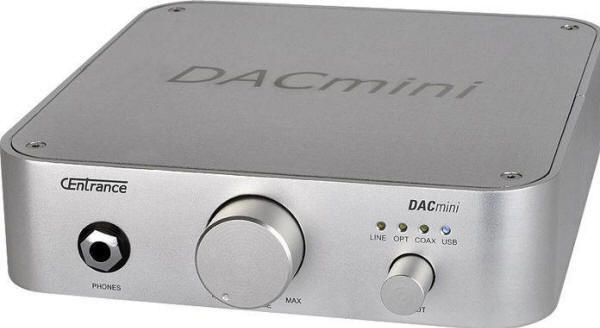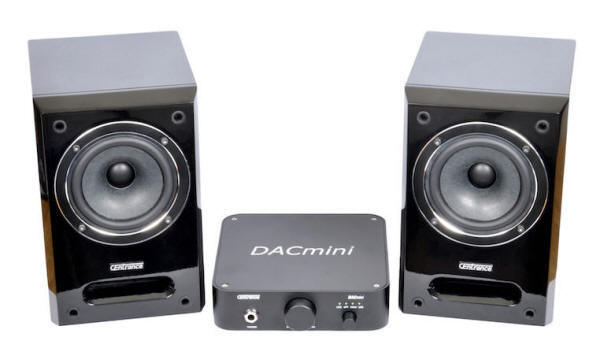|
You are reading the older HTML site
Positive Feedback ISSUE 59
The Neoteric Listener and the CEntrance Audiophile
Desktop System
Zardoz speaks to you, His chosen ones. Oh, I've known despotic computers. I didn't abandon real science for science fiction movies for nothing, so I know all about watching out for flying godheads and blinking red eyes that send you out through the space hatch. Still, my little Macbook Pro, with all of its flashing casino lights and cartoon sounds, is so benignly addicting, it's like mainlining a television. Let the talk show eggheads jabber on about how we're trading our souls for bandwidth and external storage space; I'll trade it all to be king of my virtual castle! Well…king, until the queen usurps the laptop and banishes me to the fen of knaves, but you get the idea. Card carrying audiophiles have made an art form of technology-aided entertainment in isolation, so it's a natural move to embrace computer audio and its encyclopedic access to the world's music library. Being on the forefront of an emerging playback medium and engaging in endless skirmishes about every cotton-pickin' aspect of computer audio are additional benefits. Don't worry about the stereotype of the old duffer with an armload of wax cylinders, looking for the hand crank to "Get this DAC thing a runnin'." Pay no mind to the ear bud wearing Jesse Eisenberg wannabes featured in ads for high end computer audio, the (older) kids are all right, too. The downloads Big Bang has sent audiophiles young and old hurtling along an ever expanding exploration of home or office space where they can set up a totally cool, bona-fide high end sounding computer rig to enhance their work, play, or "research." Granted, serviceable DACs can be found for less than the price of a ratty rattan chair, but today's sound gardeners are clamoring for a desktop system that delivers all the style points and nearly the wallop of a full system. Enter the CEntrance Audiophile Desktop, which, for the price of two grand, bundles a pair of MasterClass™ 2504' desktop 2-way coaxial speakers and a DACmini™ PX desktop amplifier and DAC. The Audiophile Desktop has been carefully designed so that DAC and speakers work in concert for maximum system synergy. CEntrance hopes this effort will bury once and for all the dreaded praise killing phrase: "...for a desktop system." The CEntrance DACmini CX, predecessor to the PX model, has been justifiably praised for its full sound, quiet background, and rugged build quality. The DACmini PX differs from the CX model only by adding a Class D power amplifier to complement the Class A amplifier and DAC already on board, making the PX a one stop solution for a desktop or small room system.
CEntrance first made a mark in Pro Audio engineering by collaborating and offering solutions for top companies in the recording field. This background is firmly ensconced in the layout and materials used in the Audiophile Desktop bundle, not least of which is the specially designed Pelican case that serves as a shipping container and travel-case-for-life. As someone who has hauled plenty of highly breakable and expensive sound reinforcement gear to endless crummy bars dodgy rehearsal halls, I've learned to be eternally grateful for professional grade trap cases and containers like this that get it there and back, functioning, and in one piece. Really, the case is strong enough to be shipped without any worries, and small enough to be within specified limits for storing in the overhead compartment, a welcome feature for those who like flying but not leaving things to chance. The DACmini PX is replete with nods to pro audio design, where things, as my recording engineer buddy so pithily summarized, "Need to sound perfect with no bullshit every goddamn time and not break down, especially if I can't fix it on the fly." To this end, the real-world functionality of the DACmini PX includes a Drop-protection pot guard rail and EMC barrier that protects the knobs on the front of the DACmini in the event that it takes a faceplant onto the floor below. CEntrance is pleased to note that, if the DAC falls directly on its face, a 4mm aluminum guardrail "transfers the mechanical impact from a head-on collision with the floor into the chassis support structure, away from the potentiometers, saving the fragile parts from damage." It's not hard to imagine one of these DACs falling overboard from someone experimenting with heavy speaker cables or walking away from the desk with the headphones still connected, so it's reassuring to know that your first mistake with the DACmini PX probably won't be your last. No, I didn't try out this feature, and don't suggest that you do, but the black chassis looks and feels the business. The desire to make a product that is tough as a warthog's snout is understandable, given the highly refined electronics within. And what of the sound within the electronics? Well, that's mighty fine, too. Several tropes dominate DAC chat, one of which is the merits of asynchronous vs. adaptive method in reducing USB jitter. CEntrance takes no sides on the debate, saying merely that both approaches work, if done correctly (don't include me in your jitter jihad if you disagree with their assessment, I'm just the messenger!). First off, CEntrance asserts that most products feature chips that are both DAC and USB transfer interface, and really don't do either very well. The DACmini PX, therefore, features a chip selected primarily for its ability to move USB information along, and then CEntrance developed a proprietary code to ensure that the chip is class compliant at 24/96 resolution. The PX employs something called Jitter Guard, described as "a proprietary two-stage clock management system that...cleans up the jitter on the USB bus so that samples are virtually jitter-free at the D/A conversion point." We've all heard the analogy comparing jitter to to trying to sing without really knowing all the words, and the Jitter Guard works to guarantee that the PX has the lyrics down pat. The next step is to make sure everyone hears the singer and nothing else, so CEntrance works to achieve this by squelching any and all extraneous noise through the use of full galvanic isolation between digital and analog circuitry. Signals never make an electronic connection; instead, they "travel" over a magnetic barrier. An isolated power supply, tongue and groove interlocking aluminum chassis designed to prevent EMC leakage and RF interference, and gold-plated internal wiring (no capacitors in the signal path) are only a few examples of CEntrance's quest to extricate as many sources of audio noise as reasonably possible. Making things quiet so that we can hear the exuberant parade of ones and zeros makes sense, but nobody tries to make a DAC that has all the internal noise and jitter reduction of a drunken saloon riot, so the proof, as always, is how it sounds in your system. Here's how it worked in mine.
The DACmini PX draws on years of research, and features extremely high quality materials, so I imagine somebody's head is on the chopping block if it turns out to be a dud. To someone's immense relief, it ain't. This CEntrance model shows how far DACs have come at this magic price point, long reserved for best selling integrated amps and compact disc players. The DACmini PX gives weight and dimension to music, while removing the unnatural padding that plagues lesser DACs attempting to emulate analog warmth. The biggest downfall for DACs at any level is giving body to a performance within a natural soundstage. While I prefer to restrict the word holographic to discussions involving Klingon combat rituals, I can't really think of any other way to describe how the DACmini PX distinguishes itself from many other DACs. The most noticeable characteristic of the PX, however, is how absolutely quiet it is, and how this absence of surface noise becomes strikingly evident when compared to other DACs. You simply hear more of the music. Although I am frustratingly finicky when it comes to headphones (I've heard almost all of the major ink getters, and owned and sold off plenty more, including one four digit flagship), I just had to dig out a pair of Grado SR60s to get a taste of the DACmini headphone experience. Even with this pair of cheapies, the airiness and background stillness of the PX was obviously apparent. Frankly, it was so far from the weird headphone haze-fest that normally sends me running that I can now say that I'm back in the headphone brigade. I can only imagine that those blessed with a pair of higher grade headphones will reap exponentially greater dividends from the DACmini's precise, grain-free sound. At this stage of computer audio, I find many DACs in this price range to be engaged in a game of chicken between resolution and warmth, with most models going over the edge either way. The DACmini PX works very hard to be detailed and accurate, yet retains just enough warmth to appeal to those who enjoy a less fatiguing, more forgiving approach. Still, it must be noted that this is a very accurate, honest DAC in many ways, so you can expect better sounding results from well recorded high res files. Which most of my collection is not, but I was more than happy with the results, anyway. I guess the whole point of all this is that the PX is a machine well worth owning, if all you need is a standalone DAC. But I'm not here to talk about the DACmini PX...this is a column about the CEntrance Audiophile Desktop.
And, really, it's the interaction between the DACmini PX and the MasterClass 2504 speakers that makes me jump up and holler. The MasterClass 2504 speakers employ a coplanar design that feature, according to the product info, "A full-range two-way 4' transducer, a carefully tuned bass-reflex cavity, a musical cross-over circuit with custom frequency-shaping components and 25 watts of power-handling capability." The great thing about reviewing desktop systems of this caliber is being able to experiment with a ton of variables and not having to crawl on the floor, squat behind a rack, pull cable or lug heavy furniture. Liberated from even an audiophile's version of physical effort, I had a ball comparing the DACmini PX to its famous predecessor, the DACport, as well as to a devilsound 2.1 DAC, Peachtree Audio iNova, and the new AudioEngine D2 wireless DAC (review pending). Suffice it to say, the PX was definitely the most accomplished performer of the bunch (although the AudioEngine gives it a good run for the money at half the price). Paired with the MasterClass coplanar speakers, the DACmini PX excels at creating an incredibly textured and defined soundstage. When the MasterClass speakers are brought into the room on stands or placed on the edge of a desk (a trick suggested by CEntrance mastermind, Michael Goodman), the expansion and articulation of the soundstage is immediately palpable. Tonal accuracy and seamless control throughout the frequency range also characterize the MasterClass speakers, a finding wholly appropriate to a company keenly familiar with the attributes of fine studio monitors. Substituting the 2504s for a pair of Tannoy Eyris I's quickly illustrated the importance of system design. Fine English speakers, the Tannoys, but they imparted none of the magic conveyed by the MasterClass 2504s in this configuration. The larger Tannoys certainly moved more air in the lower bass region and midband, but in a small room and, especially, desktop setting, they seem bloated and artificial by comparison. CEntrance has obviously spent a lot of time designing the 2504s to do many things well on a small scale. Minute speaker placement change, volume adjustments, speaker cable swaps, and, of course, file and streaming quality all have obvious impact on the sound, and it's fun just messing around with something that can be shaped for various preferences at will. Opening up the 2504s at higher volumes shows that they can actually go fairly loud before they give in to the laws of physics, but the Audiophile Desktop isn't really the choice I'd make if I wanted a backroom shouter. Truth is, where this DAC and speaker combo really shines is, well, you know...it's all in the name. Seated in my chair in my office, the Audiophile Desktop reminds me of another favorite hobby, that of admiring ancient Greek coins. Looking at, say, a breathtaking silver tetradachm of Amphipolis, one can't help but be moved by the exquisite detail, symmetry, and proportion in the representation of Apollo; truly a masterpiece in miniature. The Audiophile Desktop attempts to replicate this very thing, and while it would be an overstatement to call it a masterpiece, the excellent quality of the imaging, soundstage, and handling of digital audio does evoke the sound of a successfully integrated main room system. The larger the room, the more apparent it is that this system has its limitations, but on the desktop, it'll hold its own with anything near its asking price. It ships with speaker and a USB cables, too, but I imagine that most purchasers will want to have fun using the collection at home. For anyone looking for a high level computer audio desktop system that is well built and delivers a true audiophile experience, then the Audiophile Desktop is certainly a great way to make it so.
CEntrance Audiophile
Desktop
|




